The Farmhouse is a regular feature where Cody Severtson heads back to the farm to bring back bountiful harvests of prospect updates, news, and analysis.
“Why isn’t anyone taking Kole Lind?”
I genuinely wanted to avoid bringing up one of the , but it turns out that it’s actually illegal to write an article about Kole Lind without including Jim Benning’s famous declaration prior to picking Lind in the second round.
Now that I’ve got that out of the way, I can breathe a sigh of relief. But after a disappointing 2018-19 AHL debut-season, many in Canucks Nation wondered if there really was a reason why nobody was taking Kole Lind.
After having missed 21 games with injury, and spending another four as a healthy scratch, Lind’s pro debut concluded with a meagre five goals and 12 assists over 51 games played. To get an idea of how disappointing that was, his 17 points tied him for 104th overall among AHL rookies.
Lind’s debut didn’t do much to inspire confidence amongst the fanbase, especially given the lofty expectations set upon him by Canucks draft-guru, Judd Brackett, who name-dropped Elias Pettersson when talking about Lind’s hockey sense.
“Part of the draw at the draft,” , “was that his hockey sense was on a level that we thought he’d be able to play with other high-end players, someone like a Pettersson.”
Historically speaking, Lind has always struggled in his first full season in a new league. In every single one of Lind’s sophomore efforts, however, he has always rebounded with goal, assist and points-per-game totals that have doubled his debut season's numbers. It happened in Saskatchewan midget hockey, as well as the WHL, and now it looks like it could happen in the AHL.
Lind’s explosive start this season might be more indicative of Lind following a unique career trend as opposed to him being unable to handle the rigours and adjustments to pro hockey.
The Utica Comets Season So Far
Before we dive into just how impressive Lind’s season has been, let’s put it into context with how the Comets have performed.
Barring the past two weeks where I’ve been away vacationing with family in Maui; I have spent the entirety of this Utica Comets campaign .
The first, and probably most important thing to note about the Utica Comets this season is that they have routinely struggled with controlling shot-attempts at 5-on-5.
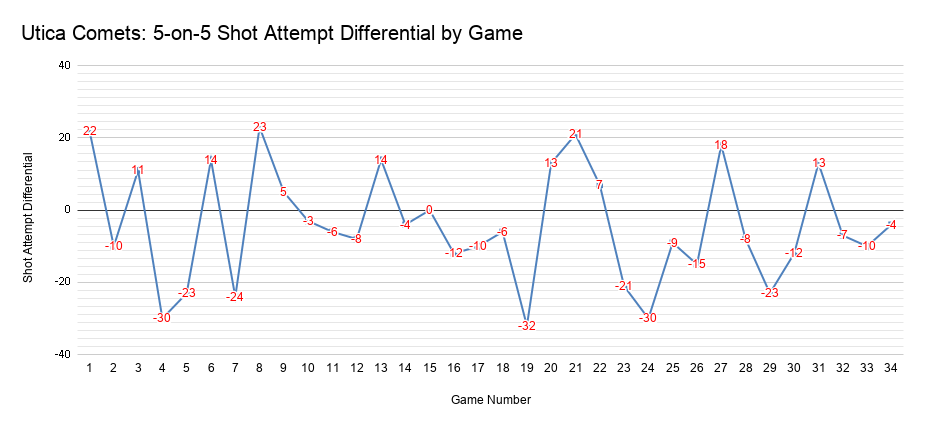 Utica Comets 5-on-5 shot differential by game.
Utica Comets 5-on-5 shot differential by game.Of the 34 games I’ve tracked, only 11 of those 34 games have the Comets managed to out-attempt their opponents at 5-on-5. Their best performance came in a 3-1 victory against the Binghamton Devils, in which they out-attempted the Devils by a 23-shot margin.
Even with a trio of fringe-NHL talents padding their roster — Sven Baertschi, Nikolay Goldobin, and Reid Boucher — the Comets still sit in the bottom three of the League in shots-for per game. The Comets are bottom-10 in the league with the ninth-most shots-allowed per-game.
Despite the unflattering shot differential, the Comets frenetic goal-scoring pace has seen them effectively outscore their problems en route to a tie for 1st in the AHL’s North Division. The Comets trail only the Belleville Senators and Stockton Heat for the third-most goals scored in the AHL. After once leading the AHL with an astonishing 5.5 goals per game, the Comets production has since normalized quite considerably but still holds steady with the fourth-best average in the league, at 3.46 goals per game.
Thanks to their ability to out-score their opponents despite being out-shot, the Comets currently sit in first place in the North Division, with a 25-14-2-2 record: 25 wins, 14 regulation losses, 2 overtime losses, and 2 shootout losses.
With that bit of background out of the way, here’s a look at how Kole Lind’s numbers stack up against his teammates, and how the development of his game has made him a key contributor to the dynamic offense of the Comets.
Lind's Offense
Lind’s emergence as a dynamic playmaking winger couldn’t have come at a better time. After losing the majority of their top-10 scoring forwards from 2018-19, significant question marks remained whether the returning forwards could step up and replace such hefty contributions.
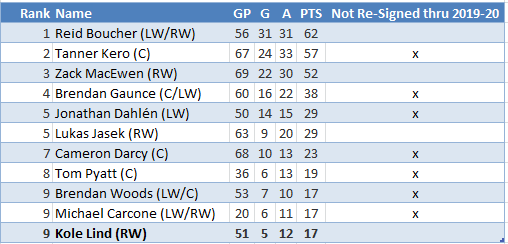 Utica Comets leading scorers 2018-19, not returning in 2019-20.
Utica Comets leading scorers 2018-19, not returning in 2019-20.All told, the Canucks organization brought back just four of the Comets top-10 scoring forwards. Technically, that includes Lind as well.
The last time the Comets elected to overhaul their forward groups to this same degree came after the 2016-17 season, where the Comets missed the playoffs for just the second time since their inception as an organization in 2013-14, two seasons removed from their Calder Finals loss to the Manchester Monarchs.
Reid Boucher has stepped up with an incredible season, Brogan Rafferty has been a revelation as a rookie, and Nikolay Goldobin and Sven Baertschi have shown why they were NHLers last season. The emergence of Lind has been key to the Comet’s success, however. Lind currently sits fourth in team scoring, largely off the strength of his playmaking and passing game.
The vision and playmaking ability that Lind has displayed this season is nothing close to the player who struggled last season. Witness these two superb passes on the power play: one to Boucher to enter the zone, then one to Baertschi for the goal.
The speed at which he’s been able to process the game at the AHL level has allowed him to execute brilliant passing plays on a night-to-night basis that frequently generate shot-attempts, scoring chances, or goals for his teammates. For instance, surrounded by Toronto Marlies in the slot, Lind is still able to spot Carter Camper down low and quickly feed him for a shot.
While I’m praising his passing, that isn’t to say his shot isn’t good, because it is, like this great finish from one knee on a superb pass from Boucher. The majority of his goals this season have come from Lind’s ability to anticipate rebounds from the high-slot area, rather than his accurate shot.
Relative to the team, Lind’s first 34 games had him sitting comfortably with the second-highest on-ice goal presence among forwards, third-highest on the team. It’s worth noting, this is all situations, not just even-strength. Lind’s deployment from head coach Trent Cull has been exclusively at 5-on-5 or on the first powerplay unit. Since Lind isn’t on the penalty kill, that certainly helps him maintain such a positive goal-differential.
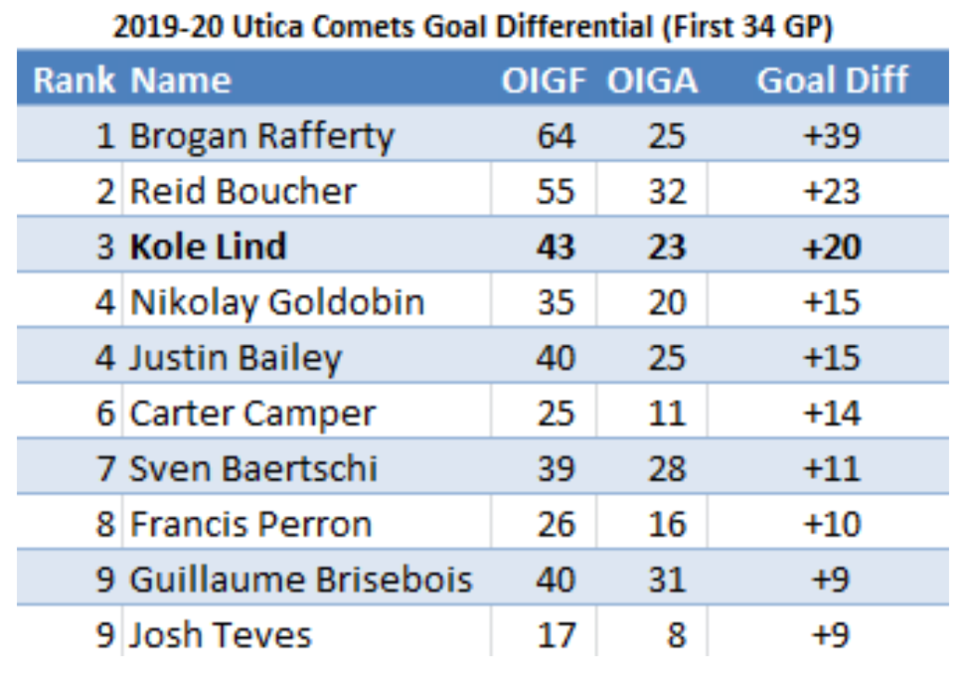 2019-20 Utica Comets goal differential through 34 games.
2019-20 Utica Comets goal differential through 34 games.There is a confidence to Lind’s game this season that has seen ordinary setups in the offensive-zone turned into scoring chances for the Comets, like this play where he undresses a Syracuse forward to give himself a clear scoring chance from between the hashmarks.
"I want Kole to have a little bit of arrogance to his game, a little bit of cockiness to his game," said Utica Comets GM Ryan Johnson at prospect camp. "It's tough [to have that confidence] when they jump into the pro level."
He seems to have that arrogance and cockiness now. This season, Lind has looked composed with the puck, seldom making unforced errors or mishandling the puck due to being pressured. Instead of panicking under pressure, he makes tough moves look easy to find space.
The Lind of last season was tenacious on the puck but lacked the skate speed to keep up with the pace of the game. Through the course of a very frustrating season, many plays concluded with weak shot-attempts, or Lind outright falling to the ice as a result of him not being strong enough on his skates.
Take this breakaway from the 2018-19 season as an example: Lind smartly gets behind the defence, but can’t create separation and is knocked off stride before he can get a shot off.
That was an area Lind focussed on in his off-season training.
“Definitely getting quicker and stronger in my legs,” said Lind at prospect camp. “I think that was something that was a key for me this summer. I worked on that week in, week out, just trying to get stronger, trying to go quicker on the ice and be a half-step ahead of the play. I felt a little slow out there last year.”
This season, Lind has been much stronger on his skates and looks significantly faster. The below example is just one of many instances where Lind displays excellent anticipation of the puck and strong skating to recover a routine dump-in from center-ice which then results in a shot-attempt for his line.
His improved skating and confidence have lent to his tenacity on the puck, and he has been one of the Comets’ most dangerous threats due to this drive to hound on loose pucks to generate offense out of nothing.
Last season, one premiere topic of conversation was the 5-on-5 production, or lack thereof, from several Canucks prospects. That hasn’t been an issue for Lind this year. With the fourth-highest 5v5 points-per-game on the Comets, Lind has more than double the amount of points at 5-on-5 than either of his fellow sophomore forwards, Lukas Jasek and Jonah Gadjovich.
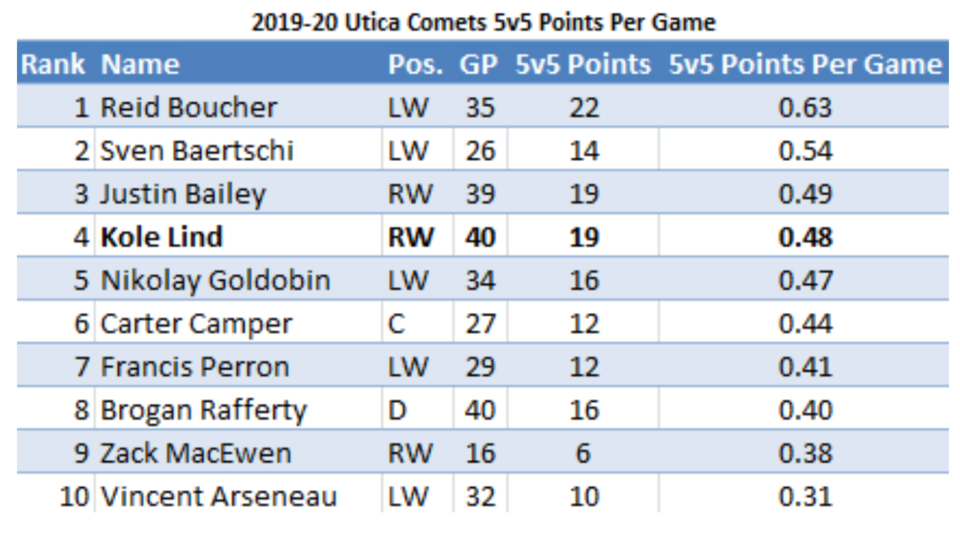 2019-20 Utica Comets points per game
2019-20 Utica Comets points per gameA lot of Lind’s success at 5-on-5 this season has to do with his vision and ability to find his teammates with his passing. For instance, against the Binghamton Devils, Lind turned a 1-on-3 situation for himself into a breakaway for Camper.
Later in the same game, Lind made a heads-up play, recognizing that he couldn’t get a strong shot off himself while in alone on the goaltender, and hooked the puck back to Boucher for an open net.
That awareness of his teammates wasn’t really present during Lind’s rookie season. On numerous occasions last year, Lind was criticized for playing a “too cute” style of hockey that resulted in many giveaways and lost time in the offensive zone. Now he’s finding his teammates in open areas with regularity.
Lind’s game has become much more efficient and calculated. When he sees an opening, he takes it, and rarely over-handles the puck like he did in his debut year. When he does handle the puck, however, his puck protection has allowed him to thrive along the endboards before he finds a teammate with a pass.
Lind's Defence
Kole Lind’s improved offensive contributions come with an asterisk, however. Like most of the Utica Comets lineup, Lind, has struggled to out-attempt opponents while playing at 5-on-5.
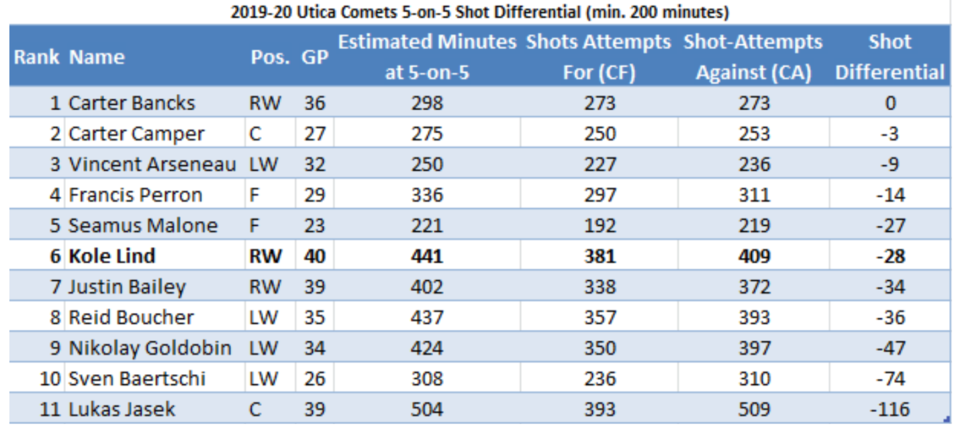 2019-20 Utica Comets shot differential
2019-20 Utica Comets shot differentialAmongst all Comets forwards who’ve logged an estimated 200+ minutes of ice-time at 5-on-5, Lind sits middle of the pack with a shot-attempt differential of minus-28. Relative to his fellow forwards, however, the Comets do control shot-attempts at 5-on-5 better with Lind on the ice, as he’s fifth on the team in relative corsi percentage.
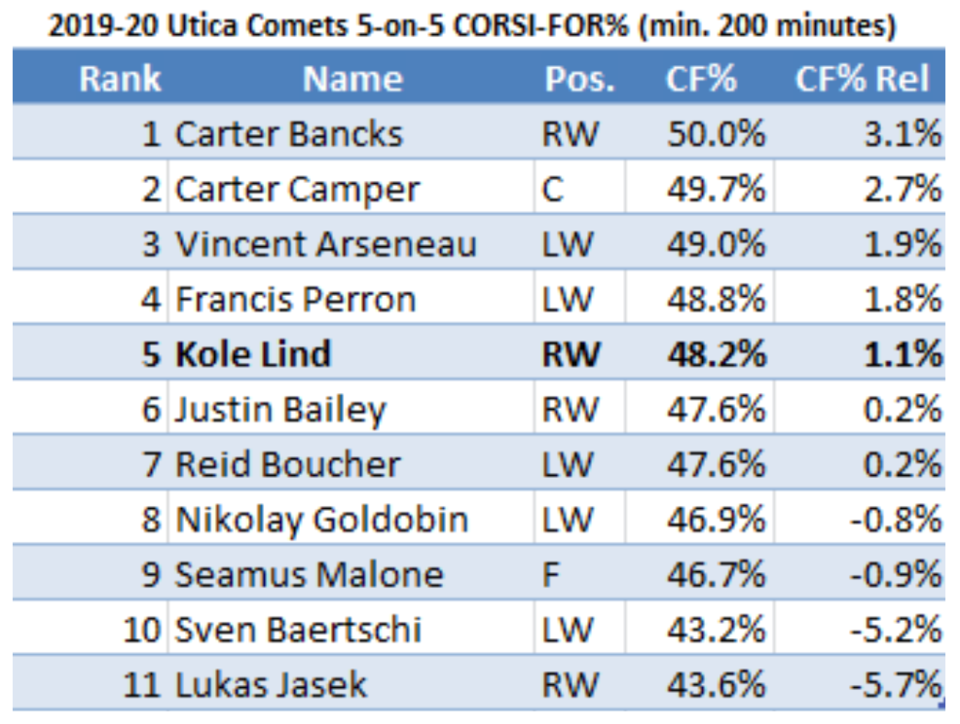
What must be said is that even his errors, like the giveaway below, usually come from Lind trying to generate something positive for the team.
This season has seen a solid improvement in Lind’s backchecking abilities. Though he does still miss some of his assignments, give away the puck, and have unforced errors here and there, his overall compete level to make up for his errors when they occur are a positive aspect of the developing defensive side of his game.
In the below example, Lind gets back defensively to get his stick on a cross-ice pass to break up a clear scoring chance. Then, when he gives the puck away, he immediately recovers to check the Syracuse forward.
Lindstigating
This is one defining aspect of Lind’s game that I have to touch on. It is possibly one of the most intriguing elements of Lind’s game because I don’t think any player drafted under the Jim Benning regime shares this aspect to their game: the ability to get under the skin of his opponents
I’d have to go back and rewatch every game to start tracking this stat, but without any facts to back it up, I will confidently go out on a limb and say that Lind leads the Comets in drawing penalties.
Earlier this season, the Utica Comets put out a MIC’D up featuring Lind, which painted a fantastic picture of the agitator aspect of his game.
While in a lot of cases, Lind does well to draw penalties, his Lindstigating does go a bit far at times and can get him in penalty trouble himself.
Couple his Lindstigating with a still-in-development defensive game and that’s a significant reason why he’s taken the third-most minor-penalties, including the most roughing minors, on the team.
Conclusion
After the Comets disappointing 2018-19 campaign, many in Canucks Nation wondered if Kole Lind would be a player for the organization even at the AHL level.
Now, as he sits at 10th in the AHL in scoring with 37 points in 43 games, that concern has been erased. With 35 games remaining in the Canucks schedule, the question might now be, “When does Kole Lind get called up?”



